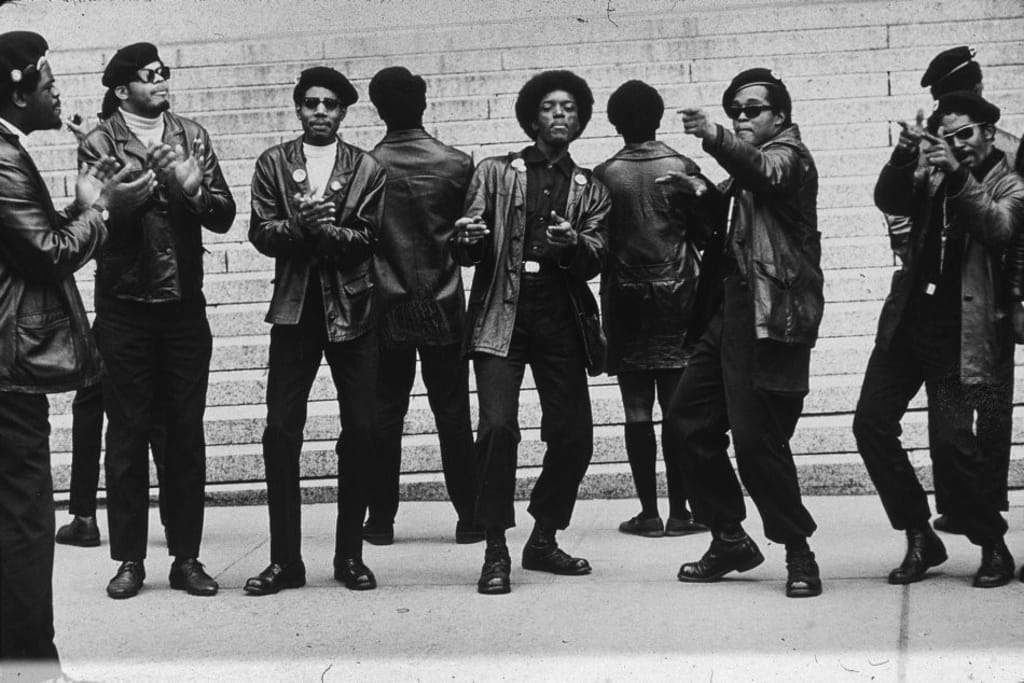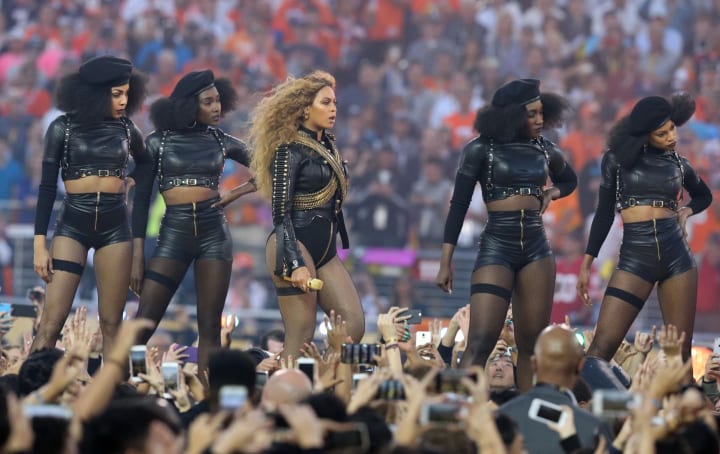The 70s Movements
How the Movements in the 70s Influenced Fashion

The 1970s was a time where people were looking for peace from all the chaos created in the 60s and were looking for freedom. People were also looking for their rights as a human being and to be equal with one another. Since the government was not listening to the people, the people claimed the streets creating many riots and protests to force them to listen to them. These occurrences opened a new door to fashion. Usually, a Designer would show his/her collection to rich clients and then to the mainstream via fashion magazines and retail shops. This was the traditional way of spreading trends. Fashion started developing from the streets as people started using fashion to vocalise their speech. In this essay, I am going to explore two of the movements in the 70s and how it influenced fashion. These fashion trends till this day have still influenced and still visibly present. The two movement that I am going to explore are the Black Power Movement and the Women's Liberation Movement as both of the movement were very big in the 70’s.
Fashion is many things, including an expression of "what is happening." It is a way for people to express themselves. In the 70s, fashion, for some people, was important in way to express the social criticism some minorities induced. For others, fashion was a way to criticise the government for its minimalism efforts in some affairs.
The Black Power Movement emerged during the mid-60s as the black community became tired of the discrimination they had to endure and how they were treated just because of the colour of their skin. During this movement, an organisation called the Black Panther Party, BPP in short, arose. It was a political organisation initiated by Bobby Seale and Huey Newton in October 15, 1966 in Oakland, California. Although it was created in 1966, it was still active in the 70s. It was an important part the civil right movement and for the Black Power Movement. The party was very influential and catalysed other movements to rise for anti-capitalist and anti-war, such as American Indian Movement and the Red Guards. The organisation was created because of the biased discrimination towards the black community enforced by the U.S. government. The party had ten agendas which included the end of police brutality and discrimination, education to all, well equipped housings, full employment and most importantly have freedom. The police brutality was unaffected, instead it increased, and there was an uproar of violence. Thus, armed members of the Black Panther would gather up and patrol around the black neighbours in the lookout for police brutality. They would also appear during police arrests of both black men and women "to make sure there was no brutality."
To allow the members of the party to stand out of the crowds and to let others know of their seriousness of their issues, the founders developed a standard uniform in 1996. The uniform included black beret, a blue shirt, black leather jacket, black trouser, black shoes, an afro, dark sunglasses, and black gloves which was optional. Some members would add other accessories to their uniform to make it their own, usually African designed jewelleries. Both founders felt that this layout of the uniform gave the member a military-like attire with very strong presences. It also a very strong way to show black power and their ‘blackness’. The members would wear their uniforms as main events, assemblies, riots and even wore it as an everyday clothing. The party was very political, however, because of its influence within the black community, it became an inspiration, creating its own type of art and trends. The trends were then brought to the Black Power Movement to symbolise black pride.
For instance, afros were well known in the black community since the 40s, but they were heavily criticised as they looked ungroomed and unattended. However, in the 70s, they started becoming a trend, especially between African-American women. The movement allowed afros to be fashionable and they started becoming bigger and bolder. It was a rejection and an oppose to white standard beauty and a symbol of black pride. This again created another movement called Black is beautiful.
The Panthers still till this day are influential as some of their demands as still not fulfilled. Nowadays, powerful figures, such as, celebrities, uses the part as a reference in their act, or just clothing, to raise awareness to the events that is going on. For example, Beyoncé performed her song, Formation, with herself and her backstage dancer wearing a some-what replica of the Panther’s uniform during a Super Bowl halftime performance in February 7, 2016 in Santa Clara, California. The performance was to remined people of police brutality and the Black Lives Matter movement.
Furthermore, for my research I will be discussing about the Women's Liberation Movement. The first movement was called the Feminist Movement and was organised in the 19th century in the United Kingdom, the United States and Ireland and since then other countries have followed its footsteps. The movement emerged as women got tired of the way they were treated as second-classed citizens. They created the movement to liberate themselves from the narrow world men had created for them. The Women's Liberation Movement was formed in the mid-60s, but it rippled throughout the 70s. it was created because of the failed promises of the government gave them perilously. In the 70s, it was the one of the biggest political scandaled movement. The movement was divided into three waves and the second waves was referred to the 60s and the 70s—the continuation of the first wave.
The movement was not just about liberation, but it was also about having gender equality. It was about having "equal pay for equal work. a chance at jobs traditionally reserved for men only, nationwide abortion reform," and many more. Although, in the US, the Equal Rights Amendment (ERA), created a bill that stated, "equality of rights under the law shall not be denied or abridged by the United States or by any State on account of sex," was introduced in 1923 to Congress, just three years after women were given the right to vote, it never made it into the House. Women continued fighting with the government for their rights, but in the 70s, they went a bit more further, they used fashion to express themselves.
Women were also fighting for their right in how they were exploited differently and wanted to reclaim how they were defined. They were against making women’s body be treated as sex objects however, the landscape of women’s wardrobe changed drastically as women in the 70s flaunted themselves in public with outfits that were unusual back then. This was one of the reason why people though and that the members of the movements were anti-fashion as they would be seen wearing clothes that that were forbidden or unusual back then. Women ignored the rules and would be seen wearing more daring, exposed clothes than ever before. The Jackie Kennedy look was gone, and women started mix-matching their wardrobe with other trends from the 70s, or were making their own.
Some women would be seen wearing clothes more that were more masculine, especially in the workplace. They wanted people to take them seriously and their cause. They would do so by wearing padded shoulders, flared trousers and bulkier looking clothing. Until the 1993, in the US, it was forbidden for women to wear trouser. They wore more casual clothing rather than nylons. And some would be seen wearing mini-skirts, midi-skirts and maxi-skirts as well. It was a time where they flaunted all or covered it all.
In 1974, a designer named Diane von Furstenberg created a new style of dressing, the wrap dress. This dress interested women as it was seen appropriate for both the office and cocktail parties the dress became one of symbols of women’s liberation and sexual freedom.
Till this day, this cause has influenced many women and have allowed women to be liberated, politically and socially. If it weren’t for the Women's Liberation Movement, it would have taken women an even longer time to achieve their demands—although women are still fighting for them. Women are still wearing trousers, now with more varieties, as well as the mini-skirts, midi-skirts and maxi-skirts. But now, women are wearing more vigorous styles depending on their own style or the way the express themselves.
To conclude my inquiry in question, it is valid to say that the movements in the 70s did influence the fashion then. It has also influenced the fashion now. The movements obligated members to find ways to express their beliefs and the found fashion one of the ways to do so. This express themselves by the clothing they wear and without knowing, the attires they wore became their voice as some of these statements making trends became their power and their symbol. These symbolised trends were so strong that people now are still being seen wearing them in a day to day basis or on events, for example, Beyoncé in February 7, 2016 in Santa Clara, California.
In addition to the statement made previously, we can further argue that the movements in the 70s have given us the freedom to wear what we want as the Black Power Movement has allowed black people to dress more freely, regardless it’s their hair or attires, since they were restricted in the past and the Women's Liberation Movement has allowed women in general to wear what they want, whether it is trousers or skirts, as forbidden trends then have now become mainstream.

Matthew Emmons / USA Today
About the Creator
Prativa Rai
A Fashion student who just wants to research and blog during her spare time.






Comments
There are no comments for this story
Be the first to respond and start the conversation.